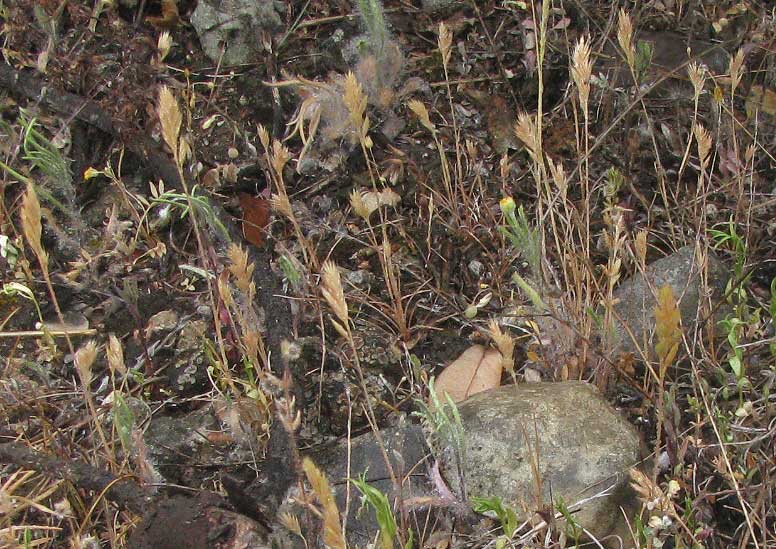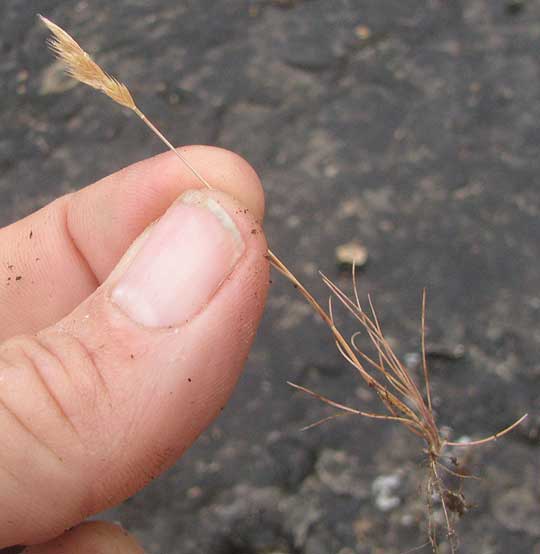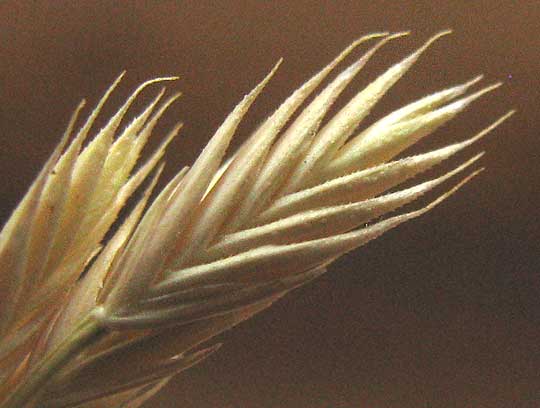Excerpts from Jim Conrad's
Naturalist Newsletter

from the April 27, 2014 Newsletter issued from the Frio Canyon Nature Education Center in the valley of the Dry Frio River in northern Uvalde County, southwestern Texas, on the southern border of the Edwards Plateau; elevation ~1750m (~5750 ft); N29.62°, W99.86°; USA
SIX-WEEKS FESCUE
A couple of weeks ago we found some interesting, not-very-common plants in a special habitat consisting of highly calcareous soil collected in a tub-size depression in the hard, bare Edwards Limestone capping our hill here. Below, you can see a picture of that extreme habitat:

Growing among the Split-leaf Gilia and Hilly Sandwort, which made that little natural pothole so special, grew a tiny grass. It bore immature flowers then, but now two weeks later already the grass plants are dead and dried-out, and their heads bear grains ready for dispersal. I figured that if this lilliputian grass thrived in such a unique habitat, it might be something special, and I've been looking forward to identifying it. At the top of this page you can see several of the brown, dried-up grasses are shown in their thin, crusty, rocky, extremely dry soil. Below, you can see how small the plants are relative to my fingers:

In structure, this plant is very similar to several common grasses, such as the fescues and brome grasses, but its tiny size is remarkable. A close-up of a spikelet on a short stem, or pedicel, consisting of ten or so florets with sharply long-pointed lemmas is shown below:

Three of a flowering head's broken-apart florets are seen beneath the dissecting scope below:

Along with the above-mentioned features, to identify this species it's important to notice that the sharp-pointed lemmas display no conspicuous veins on their rounded backs. Also, each spikelet's two lowermost scales, the glumes, are not quite as long as the lemmas.
Back when I was learning my plants, these features would have led me right to the fescue grasses, genus Festuca. However, since those days taxonomists have shifted several fescue species to the genus Vulpia, and this is one of those. It's a widely distributed grass, so it goes by many names, including Sixweeks Fescue, Sixweeks Grass, Eight-flowered Fescue and Pullout Grass. It's VULPIA OCTOFLORA, native from southern Canada through all the lower 48 states and the arid northern half of Mexico. Presumably the "six weeks" part of its name is based on the grass' supposed lifespan.
Sixweeks Fescue is not at all restricted to such habitats as our hilltop pothole. It's described as inhabiting not only hilltop "balds" like we have here but also ledges, ridges, meadows, fields, and many kinds of weedy, disturbed sites.